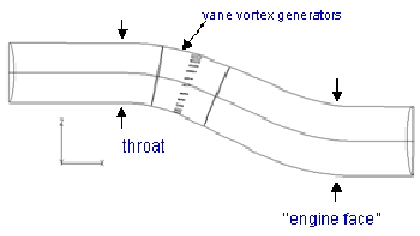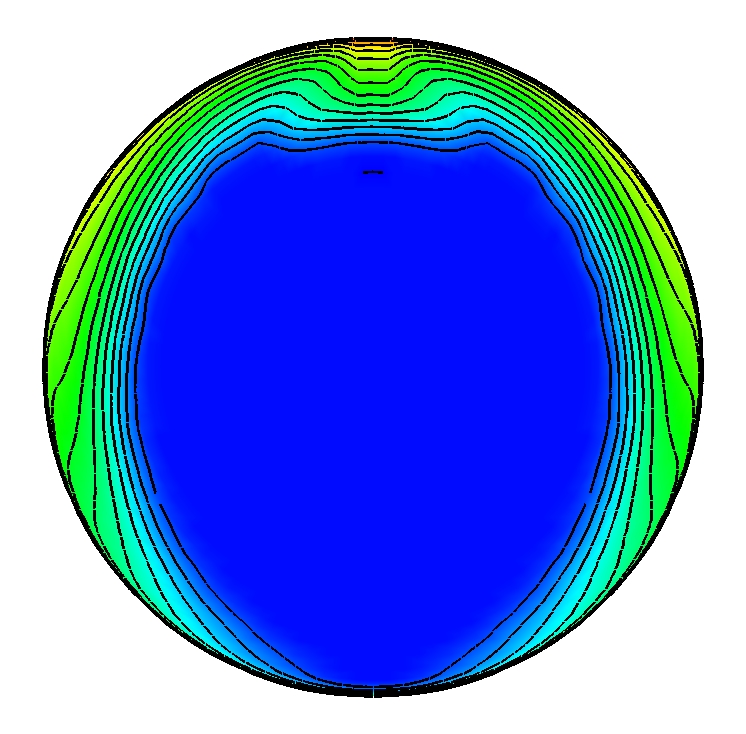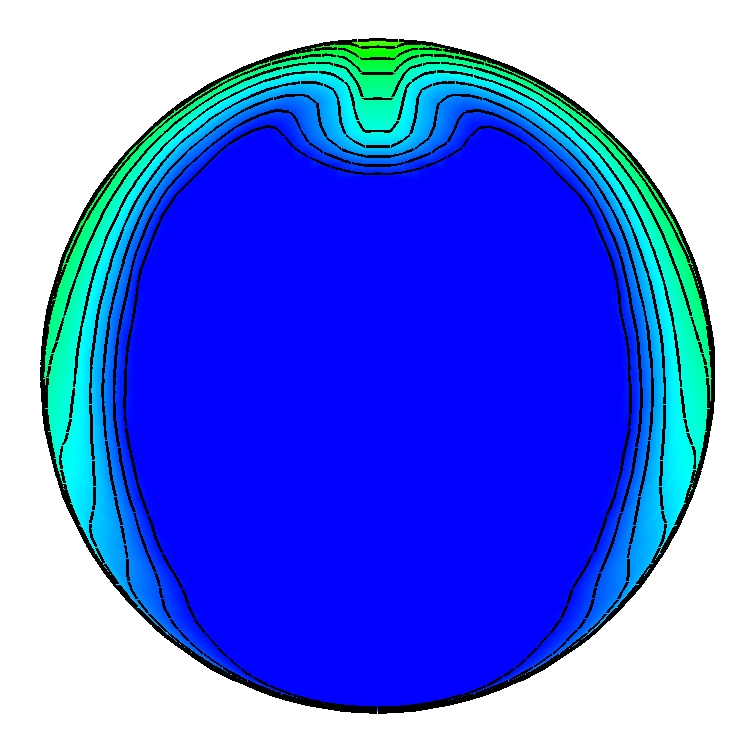
NPARC Alliance Validation Archive
Validation Home >
Archive >
S-Duct Inlet >
Study #2

In this study, viscous flow in the M2129 circular S-duct is examined for a throat Mach number 0.78. The duct has vane-type vortex generators equally spaced in a co-rotating arrangement as shown in Fig. 1. The Wind-US results are compared with experimental data and with Wind-US simulations with the VGs represented as gridded flat-plate vanes.
All of the archive files of this validation case are available in the Unix compressed tar file sduct02.tar.gz. The files can then be accessed by the commands
gunzip sduct02.tar.gz
tar -xvof sduct02.tar
The geometry which was tested experimentally is test case 3 from the AGARD study of Ref. 1, and was referred to as the M2129 duct in the experimental investigations of Ref. 2. This duct has a circular cross section and an S-shaped centerline, and is shown in Fig. 1. The duct is approximately 2 ft (0.61 m) in length, and the throat, which is located at the end of the upstream straight section, is 5.06 in. (12.9 cm) in diameter. The engine face, or aerodynamic interface plane (AIP), is located at an axial station of 19.27 in (48.9 cm), it's diameter is 6.0 in. (15.2 cm), and the duct offset is 5.4 in. (13.7 cm).
The VG configuration tested is referred to as VG170 in Ref. 2 and contains 11 flat-plate vanes per half duct, located one inlet diameter downstream of the inlet throat. Each generator has a height-to-chord ratio of 0.25, where the chord is approximately 0.7 in. (1.8 cm) and an angle of incidence is 16 deg. The incidence was chosen to turn the flow near the wall away from the bottom of the duct, and ideally counteract the formation of the duct vortex.
The computational grid used for this simulation is sduct02.cgd and it is shown in Fig. 2. Since the duct is symmetric about the x-z-plane, only half of the duct is gridded. The grid has four zones, and the vortex generator model is applied at the interface between zones 2 and 3, which is located at the generator trailing edge station. The grid spacing in the vicinity of the generators as a percentage of the VG chord length is 0.26 in the axial direction, 0.64 in the radial direction and 0.54 in the circumferential direction. The grid has a total of 691,790 points as given below. The grid in the formatted, multi-block Plot3D format is available in the file sduct02.x.fmt.
| Zone | Dimensions (psia) |
|---|---|
| 1 | 26x61x49 |
| 2 | 23x277x50 |
| 3 | 14x277x50 |
| 4 | 34x61x49 |

An initial condition of freestream flow was used, as given in Table 1:
| Mach number | Total Pressure (psia) | Total Temperature(R) | Angle-of-Attack (deg) |
|---|---|---|---|
| 0.7 | 14.67 | 517.0 | 0.0 |
In all four blocks, the KMAX boundary is a VISCOUS WALL, the KMIN boundary is a SINGULAR AXIS, and the J1 and JMAX boundaries are set to REFLECTION. In ZONE 1, the I1 boundary is set to ARBITRARY INFLOW. In ZONE 4, the IMAX boundary is set to OUTFLOW. The zonal interfaces on the I-boundaries between zones are all coupled. The vortex generator model is addressed in the Input Parameters and Files section.
The boundary conditions are specified using GMAN. This was done using the command:
gman < gman.sduct02.com
where the file gman.sduct02.com is a command input file. This file instructs GMAN to read in the sduct02.cgd grid file, and to set all of the boundary conditions. This could also be done using GMAN's graphical mode. (For a good example case using GMAN's graphical mode, see the Laminar Flat Plate case.)
The computation is performed using the time-marching capabilities of WIND to approach the steady-state flow starting from the freestream conditions. Local time stepping is used at each grid point to speed up convergence. The flow is assumed to be fully turbulent. The first two runs establish the baseline flow without the vortex generators. The Wendt vortex generator model is then applied for runs 3 through 6.
This case is computed in six runs and the corresponding input data files for WIND-US are sduct02.dat.1, and sduct02.dat.2, which are baseline cases run without the vortex generators and cases sduct02.dat.3, sduct02.dat.4, sduct02.dat.5 and sduct02.dat.6 which are run with the Wendt vortex generator model used to specify 11 flat plate vanes, equally spaced about the circumference of the half-duct. The FREESTREAM keyword is used to specifiy the freestream conditions, which are given in Table 2, above. For ZONE 1, the ARBITRARY INFLOW keyword indicates that the total temperature and the local flow angles are held constant, and the inflow is uniform and matches the freestream conditions. The DOWNSTREAM PRESSURE keyword sets the outflow pressure in ZONE 4 to 12.63 psi. The TURBULENCE keyword indicates that the Spalart-Allmaras turbulence model is used. The CFL# keyword sets the initial CFL number to 0.5 for the first 500 iterations, then increments it by a factor of 1.1 every 100 iterations until it reaches a value of 2.0, where is then held constant. Each run consists of 1000 cycles with 5 iterations per cycle for a total of 5000 iterations per run. The LOADS keyword is used to print out the mass flux at the I=34 of plane of ZONE 4 every 10 iterations. This is used to monitor convergence.
The Wendt vortex generator model is used in runs sduct02.dat.3, sduct02.dat.4, sduct02.dat.5 and sduct02.dat.6. Eleven generators are specified at varying z-locations on the KMAX wall boundary at the interface between zones 2 and 3. Each vortex generator has a chord length of 0.7 inches, height of 0.175 inches, an angle of incidence of -16 degrees. The local velocity of 668 ft/sec and boundary layer thickness of 0.17 inches were obtained from the baseline solution of run 2, sduct02.cfl.2.
To run WIND-US, the input data file for the first run, sduct02.dat.1, was copied to sduct02.dat and the WIND-US job was run using the following command:
wind -dat sduct02 -grid sduct02Since the wind_post post processing script was located in the run directory; it automatically submitted runs 2 through 6 in succession as each respective preceding run was completed. The resulting solution files for each run are sduct02.cfl.1, sduct02.cfl.2, sduct02.cfl.3, sduct02.cfl.4, sduct02.cfl.5, and sduct02.cfl.6. The resulting output list file is sduct02.lis.
The RESPLT utility was used to obtain convergence history information from sduct02.lis. The following command was used to obtain the file chist.l2.gen, which contains the L2 residual in GENPLOT format.
resplt < resplt.1.com
Where the file resplt.1.com is a command input file. In the same manner, the command file resplt.2.com was used to create the GENPLOT file chist.mass.gen containing the mass flux history at the exit plane of zone 4. The plots of these results were created using the CFPOST postprocessing program and the files cfpost.1.com and cfpost.2.com as follows.
cfpost < cfpost.1.com
cfpost < cfpost.2.comThe resulting plots are shown in Fig. 3, below.


The L2 residuals oscillate at values near 10-2 for zones 2 and 3, and near 10-4 for zones 1 and 4, and never actually show a big drop, as in the inviscid s-duct case of study 1 . Rather than using the L2 residuals as the criteria for convergence, the convergence of the quantities of interest -- the total pressure recovery, the throat Mach number and the mass flux -- were used. This case was considered converged after approximately 20,000 iterations, at which point, the the total pressure recovery at the aerodynamic interface plane (AIP) converged to within four significant figures, and the throat Mach number to converged to three significant figures. Also, as shown in Fig. 3b, the mass flux has also converged.
| Case | No. Iter. | AIP Total Pressure Recovery | Throat Mach Number |
|---|---|---|---|
| 5000 | |
|
|
| |
10000 | |
|
| 15000 | |
|
|
| |
20000 | |
|
| |
25000 | |
|
| |
30000 | |
|
| Experiment | |
|
|
| Gridded Vanes | 30000 | |
|
The total pressure recovery at the AIP in the model simulations will usually be a little higher than expected because the Wendt vortex generator model does not account for the total pressure losses caused by the physical blockage or drag of the vanes in the duct. It is better to use the model for predicting the correct trend in recovery, rather than predicting the specific value.
To compute the AIP total pressure recovery and the throat Mach number values listed in Table 3 above, the CFPOST postprocessor was used with the command file cfpost.avg.com as follows.
cfpost < cfpost.avg.com
This produces two output files named cf.aip.n.lis and cf.thrt.n.lis, where n corresponds to the run number. It is left to the user to edit the file cfpost.avg.com for each case so that the .cfl file CFPOST reads and the output file it writes have corresponding names.
The total pressure at the duct AIP, located at an axial station of 19.3 inches, was plotted using the commercially available CFD postprocessing software Fieldview. The results of a previously computed gridded vane solution (See Ref. 3) and the solution computed in this study using the vortex generator model, are shown in Fig. 4, below.


a. | |
| | | | |
| | | | |
| | | | |
| | | | |
| | | | |
| | | | |
| | |
| b. |
|
|---|
These cases were run using WIND-US Version 2.12 on an HPXW6200 LINUX workstation. It took a total of 284,990 CPU seconds to run 20000 iterations or approximately 20.8 CPU sec/(iter-node). The cases which used the Wendt vortex generator model did not require any additional CPU time.
1. "Air Intakes for High Speed Vehicles," AGARD-AR-270 (AGARD Advisory Report 270), Fluid Dynamics Panel Working Group 13, September, 1991
2. Anderson, B. H., and Gibb, J., "Vortex Generator Installation Studies on Steady State and dynamic Inlet Distortion," AIAA Paper 96-3279, July 1996.
3. Dudek, J. C., "Empirical Model for Vane-Type Vortex Generators in an Navier-Stokes Code", AIAA Journal, Vol. 44, No. 8, pp 1779-1789,August 2006.
This case was created on November 15, 2007 by Julianne C. Dudek, who may be contacted at
NASA Glenn Research Center, MS 5-12
21000 Brookpark Road
Cleveland, Ohio 44111
Phone: (216) 433-2188
e-mail: Julianne.C.Dudek@nasa.gov